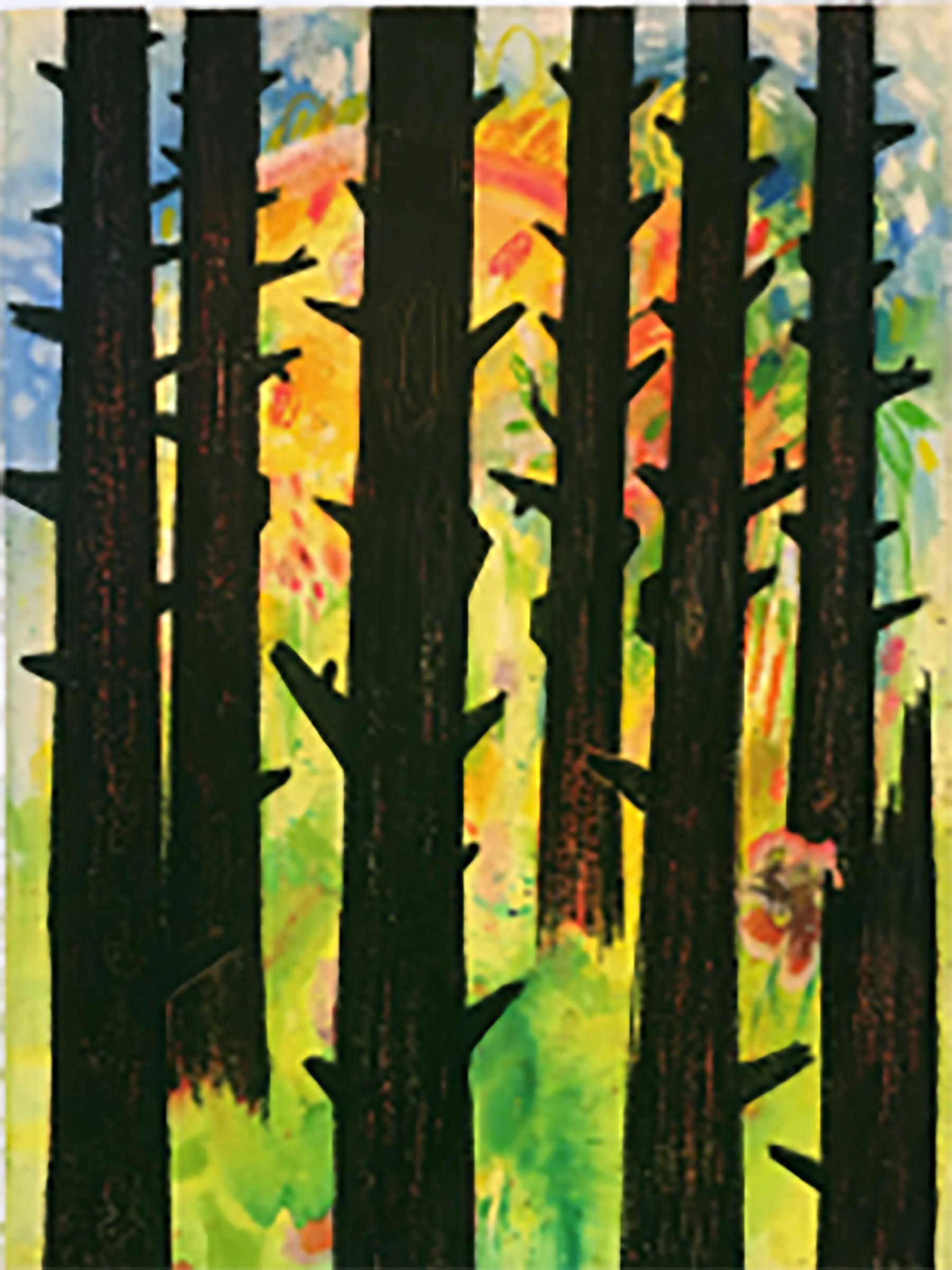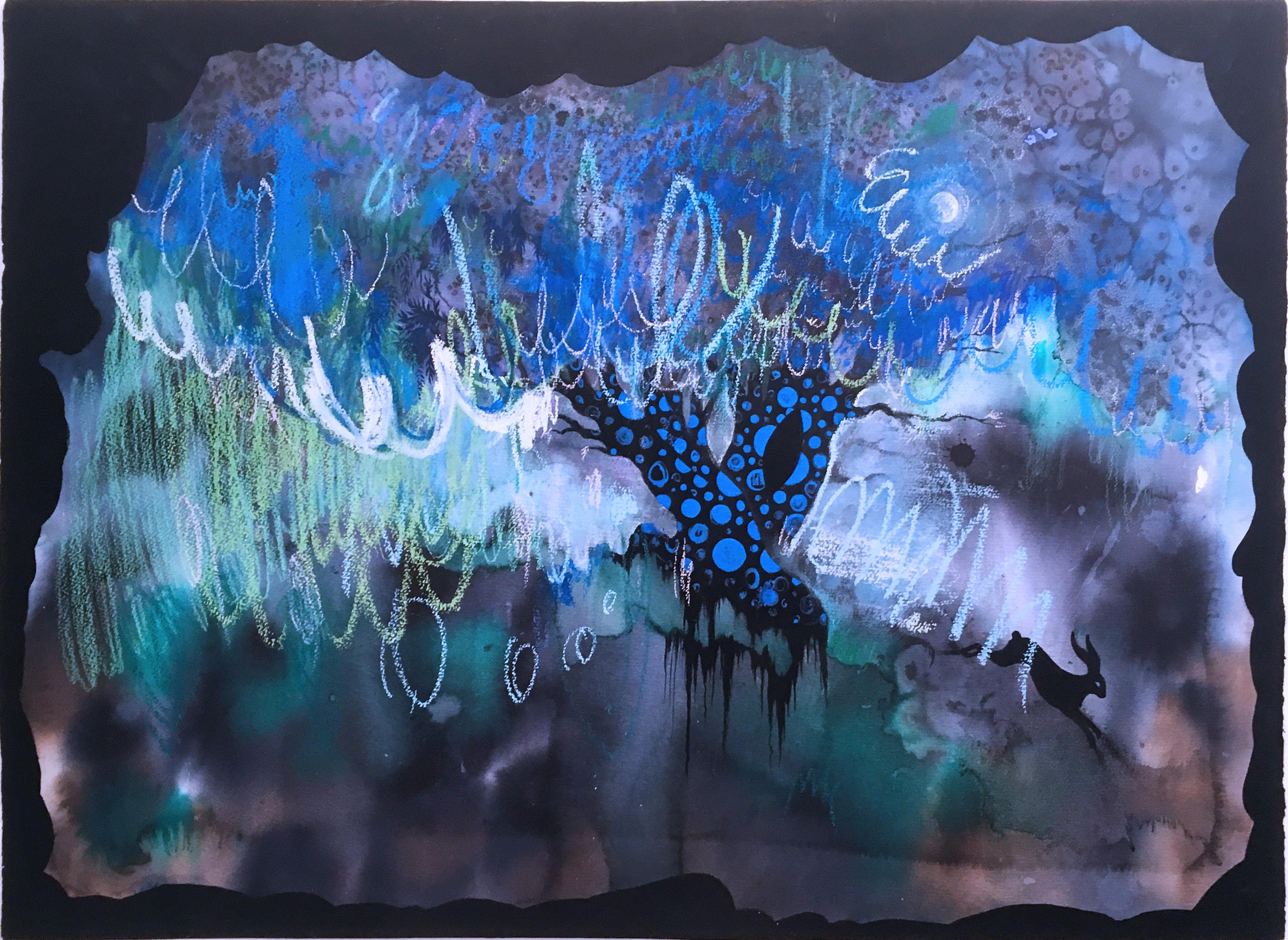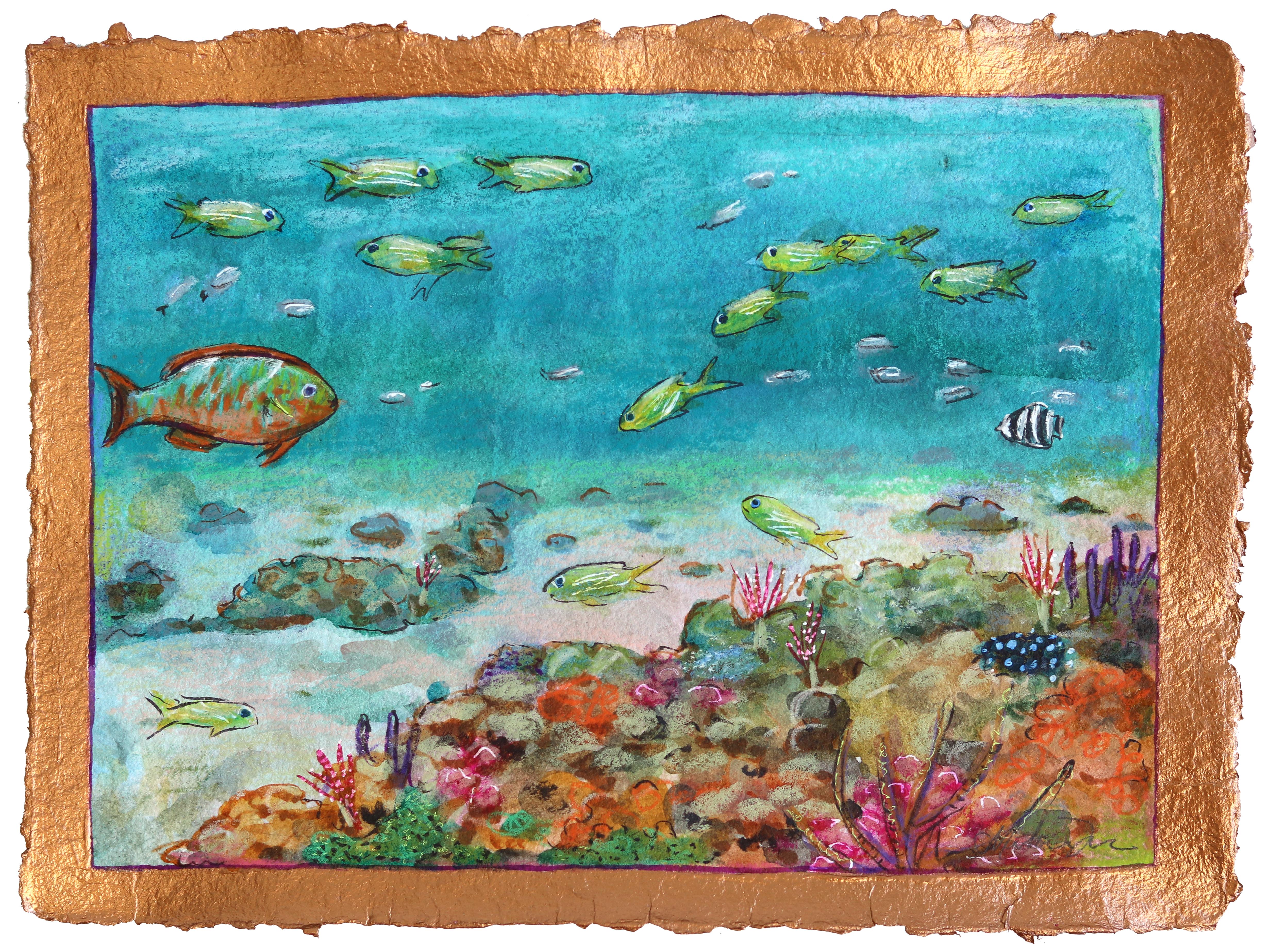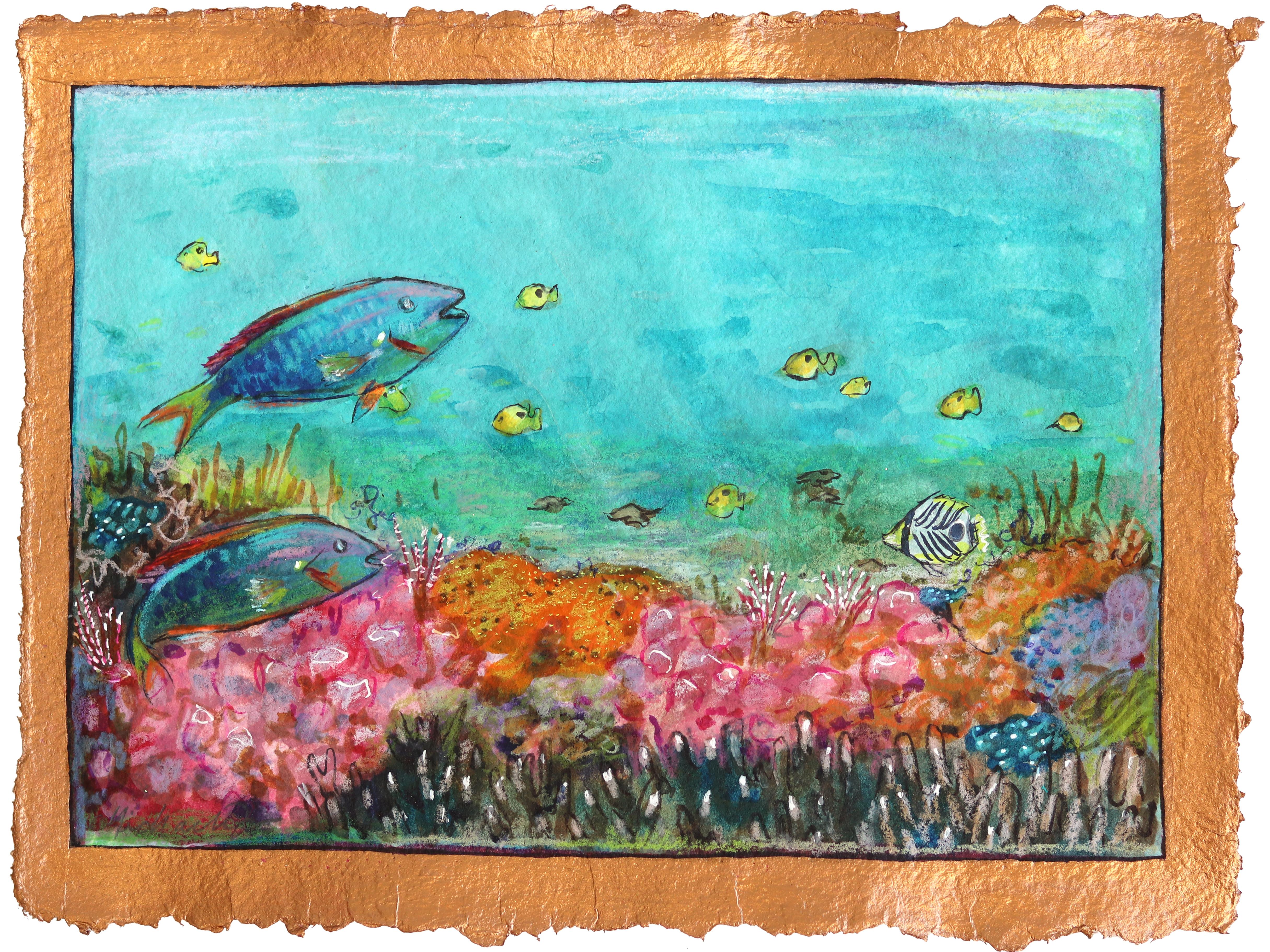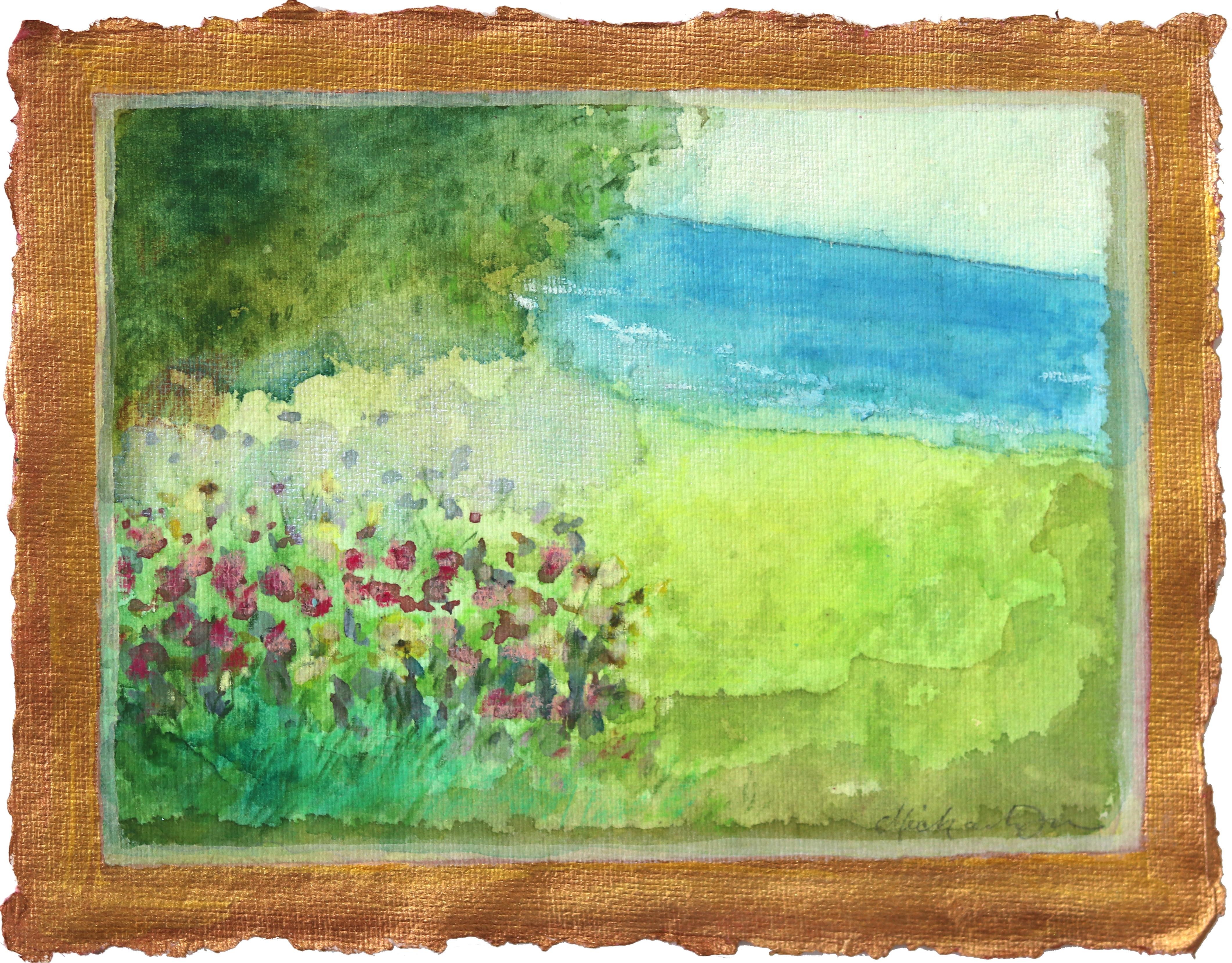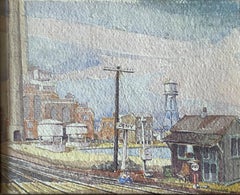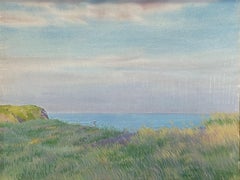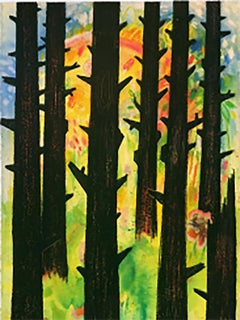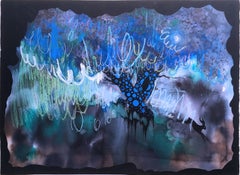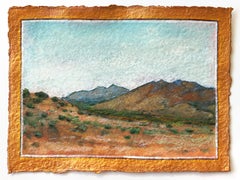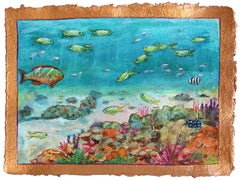Items Similar to "Andes Mountains Peru South America, " Joseph Yoakum, Black Folk Art Landscape
Want more images or videos?
Request additional images or videos from the seller
1 of 8
Joseph Yoakum"Andes Mountains Peru South America, " Joseph Yoakum, Black Folk Art Landscapecirca 1960s
circa 1960s
About the Item
Joseph Yoakum
Andes Mountains Peru So America, circa 1960s
Colored pencil and ballpoint pen on paper
7 1/4 x 10 1/2 inches
Provenance:
Karen Lennox Gallery, Chicago
Private Collection, South Dakota
Yoakum began drawing in the early 1960s. Most of his work consists of radiantly colored landscapes with mountains, water, trees, and winding roads in abstract and complex configurations. his period of greatest activity — 1965 to 1970 — when he usually made one drawing a day.
Yoakum maintained he had seen all the places represented in his drawings, a statement that may not be true in some instances. He traveled a great deal, beginning in his early teens when he ran away from home and became a circus handyman. Yoakum’s drawings can be considered memory images growing out of either actual or imagined experiences. All of his drawings have titles that grew longer and more specific over the years. He dated his works with a rubber stamp — an oddly impersonal, labor-saving device.
Although Joseph Yoakum gave vastly different accounts of his background, he was, throughout his life, classified as an African American. Sometimes Yoakum claimed that he was a full-blooded “Nava-joe” Indian, one of twelve or thirteen children born to a farmer on an Indian reservation in Window Rock, Arizona. At other times he insisted that he was of African-American descent. He described his mother as a strong woman who was a doctor and knowledgeable in the use of herbal medicines. Yoakum’s family moved to Kansas City, Missouri, during his early childhood. His father was employed briefly in the railroad yards prior to settling permanently on a farm in nearby Walnut Grove in southwest Missouri. Although Yoakum said that his formal schooling consisted of only three or four months, the character of the notations on his drawings suggests greater exposure to formal training.
The early years of Yoakum’s life were apparently nomadic. He claimed to have run away from home during his early teens to join a circus. He also claimed to have worked with Buffalo Bill before 1903, when he became the personal valet of John Ringling of the Ringling Brothers Circus. Between 1905 and 1910, Yoakum may have visited Europe, Russia, Mexico, the Middle East, China, Siberia, Canada, Central America, and South America. His first marriage occurred around 1910 and produced five children. He married again in 1929.
Yoakum served in the Unites States Army during World War I and was stationed at one time in France. The specific location and nature of his activities after his military discharge until his artistic career began in the early 1960s are uncertain. Yoakum said that he worked at a variety of jobs throughout the United States. In the early 1940s, he and his wife operated an ice cream parlor on Chicago’s South Side. By the late 1950s, however, Yoakum was widowed, retired, and living in a housing project for the elderly in Chicago. In 1966, Yoakum moved from the project to a storefront on the South Side. He lived there until he was hospitalized and placed in a nursing home in 1971; he died there the following year.
According to Yoakum, he was motivated to draw as the result of a dream around 1962. He described his process of working as a “spiritual enfoldment,” meaning that his imagery was revealed as he worked. Yoakum’s earliest drawings were done on small pieces of white or Manila paper with pen or pencil and little or no color. He graduated to larger pieces of paper and applied more color to his drawings as he drew with greater frequency.
Although Yoakum enjoyed doing celebrity-oriented portraits, the majority of his drawings are landscapes. In his hundreds of variations, real or imagined, mountains and water are the major themes. Between 1965 and 1970, Yoakum drew constantly and sometimes completed several pictures a day, often similar in theme, yet distinctly different in design. He kept an assortment of travel books, an atlas, and the Encyclopedia Britannica and took great pains to include inscriptions that name geographical details ranging from valleys to continents. Nonetheless, the scenes in Yoakum’s landscapes are generally not identifiable. Yoakum usually signed and dated his landscapes in the upper left corner. Occasionally he used a rubber stamp to indicate the date adding what he called a “touch of class.” Yoakum’s world was intensely private. His religious beliefs were rooted in the view that God and nature were the same thing. He expressed this belief in hundreds of drawings that are delicate, sensitive, and poetic in contrast to the bold, if not brash, character of most contemporary folk art.
- Creator:Joseph Yoakum (1890 - 1972, American)
- Creation Year:circa 1960s
- Dimensions:Height: 13.5 in (34.29 cm)Width: 17 in (43.18 cm)
- Medium:
- Movement & Style:
- Period:
- Condition:
- Gallery Location:New York, NY
- Reference Number:1stDibs: LU1841211574642
About the Seller
5.0
Platinum Seller
Premium sellers with a 4.7+ rating and 24-hour response times
Established in 2022
1stDibs seller since 2022
104 sales on 1stDibs
Typical response time: <1 hour
- ShippingRetrieving quote...Shipping from: New York, NY
- Return Policy
Authenticity Guarantee
In the unlikely event there’s an issue with an item’s authenticity, contact us within 1 year for a full refund. DetailsMoney-Back Guarantee
If your item is not as described, is damaged in transit, or does not arrive, contact us within 7 days for a full refund. Details24-Hour Cancellation
You have a 24-hour grace period in which to reconsider your purchase, with no questions asked.Vetted Professional Sellers
Our world-class sellers must adhere to strict standards for service and quality, maintaining the integrity of our listings.Price-Match Guarantee
If you find that a seller listed the same item for a lower price elsewhere, we’ll match it.Trusted Global Delivery
Our best-in-class carrier network provides specialized shipping options worldwide, including custom delivery.More From This Seller
View All"Tugboat at Dock, " Reginald Marsh, Modern WPA Industrial Ship
By Reginald Marsh
Located in New York, NY
Reginald Marsh
Tugboat at Dock, circa 1937
Signed lower right
Watercolor and pencil on paper
13 3/4 x 20 inches
Housed in a Lowy frame.
Provenance:
Sotheby'...
Category
1930s Modern Landscape Paintings
Materials
Paper, Watercolor, Pencil
"Gray Morning" James MacMaster, Scottish Seascape, Marine Ship Landscape
By James MacMaster
Located in New York, NY
James MacMaster
Gray Morning
Signed and titled lower left
Watercolor on paper
10 1/4 x 14 inches
Provenance:
Private Collection, New Jersey
Category
Late 19th Century Landscape Paintings
Materials
Paper, Watercolor
$540 Sale Price
70% Off
"Train Station, " Max Kuehne, Industrial City Scene, American Impressionism
By Max Kuehne
Located in New York, NY
Max Kuehne (1880 - 1968)
Train Station, circa 1910
Watercolor on paper
8 1/4 x 10 1/4 inches
Signed lower right
Provenance:
Private Collection, Illinois
Max Kuehne was born in Halle, Germany on November 7, 1880. During his adolescence the family immigrated to America and settled in Flushing, New York. As a young man, Max was active in rowing events, bicycle racing, swimming and sailing. After experimenting with various occupations, Kuehne decided to study art, which led him to William Merritt Chase's famous school in New York; he was trained by Chase himself, then by Kenneth Hayes Miller. Chase was at the peak of his career, and his portraits were especially in demand. Kuehne would have profited from Chase's invaluable lessons in technique, as well as his inspirational personality. Miller, only four years older than Kuehne, was another of the many artists to benefit from Chase's teachings. Even though Miller still would have been under the spell of Chase upon Kuehne's arrival, he was already experimenting with an aestheticism that went beyond Chase's realism and virtuosity of the brush. Later Miller developed a style dependent upon volumetric figures that recall Italian Renaissance prototypes.
Kuehne moved from Miller to Robert Henri in 1909. Rockwell Kent, who also studied under Chase, Miller, and Henri, expressed what he felt were their respective contributions: "As Chase had taught us to use our eyes, and Henri to enlist our hearts, Miller called on us to use our heads." (Rockwell Kent, It's Me O Lord: The Autobiography of Rockwell Kent. New York: Dodd, Mead and Co., 1955, p. 83). Henri prompted Kuehne to search out the unvarnished realities of urban living; a notable portion of Henri's stylistic formula was incorporated into his work.
Having received such a thorough foundation in art, Kuehne spent a year in Europe's major art museums to study techniques of the old masters. His son Richard named Ernest Lawson as one of Max Kuehne's European traveling companions. In 1911 Kuehne moved to New York where he maintained a studio and painted everyday scenes around him, using the rather Manet-like, dark palette of Henri.
A trip to Gloucester during the following summer engendered a brighter palette. In the words of Gallatin (1924, p. 60), during that summer Kuehne "executed some of his most successful pictures, paintings full of sunlight . . . revealing the fact that he was becoming a colorist of considerable distinction." Kuehne was away in England the year of the Armory Show (1913), where he worked on powerful, painterly seascapes on the rocky shores of Cornwall. Possibly inspired by Henri - who had discovered Madrid in 1900 then took classes there in 1906, 1908 and 1912 - Kuehne visited Spain in 1914; in all, he would spend three years there, maintaining a studio in Granada. He developed his own impressionism and a greater simplicity while in Spain, under the influence of the brilliant Mediterranean light. George Bellows convinced Kuehne to spend the summer of 1919 in Rockport, Maine (near Camden). The influence of Bellows was more than casual; he would have intensified Kuehne's commitment to paint life "in the raw" around him.
After another brief trip to Spain in 1920, Kuehne went to the other Rockport (Cape Ann, Massachusetts) where he was accepted as a member of the vigorous art colony, spearheaded by Aldro T. Hibbard. Rockport's picturesque ambiance fulfilled the needs of an artist-sailor: as a writer in the Gloucester Daily Times explained, "Max Kuehne came to Rockport to paint, but he stayed to sail." The 1920s was a boom decade for Cape Ann, as it was for the rest of the nation. Kuehne's studio in Rockport was formerly occupied by Jonas Lie.
Kuehne spent the summer of 1923 in Paris, where in July, André Breton started a brawl as the curtain went up on a play by his rival Tristan Tzara; the event signified the demise of the Dada movement. Kuehne could not relate to this avant-garde art but was apparently influenced by more traditional painters — the Fauves, Nabis, and painters such as Bonnard. Gallatin perceived a looser handling and more brilliant color in the pictures Kuehne brought back to the States in the fall. In 1926, Kuehne won the First Honorable Mention at the Carnegie Institute, and he re-exhibited there, for example, in 1937 (Before the Wind). Besides painting, Kuehne did sculpture, decorative screens, and furniture work with carved and gilded molding. In addition, he designed and carved his own frames, and John Taylor Adams encouraged Kuehne to execute etchings. Through his talents in all these media he was able to survive the Depression, and during the 1940s and 1950s these activities almost eclipsed his easel painting. In later years, Kuehne's landscapes and still-lifes show the influence of Cézanne and Bonnard, and his style changed radically.
Max Kuehne died in 1968. He exhibited his work at the National Academy of Design, the Art Institute of Chicago, the Carnegie Institute in Pittsburgh, the Memorial Art Gallery of the University of Rochester, and in various New York City galleries. Kuehne's works are in the following public collections: the Detroit Institute of Arts (Marine Headland), the Whitney Museum (Diamond Hill...
Category
1910s American Impressionist Landscape Drawings and Watercolors
Materials
Paper, Watercolor
"Monhegan Island, Maine, " Edward Dufner, American Impressionism Landscape View
By Edward Dufner
Located in New York, NY
Edward Dufner (1872 - 1957)
Monhegan Island, Maine
Watercolor on paper
Sight 16 x 20 inches
Signed lower right
With a long-time career as an art teacher and painter of both 'light' and 'dark', Edward Dufner was one of the first students of the Buffalo Fine Arts Academy to earn an Albright Scholarship to study painting in New York. In Buffalo, he had exchanged odd job work for drawing lessons from architect Charles Sumner. He also earned money as an illustrator of a German-language newspaper, and in 1890 took lessons from George Bridgman at the Buffalo Fine Arts Academy.
In 1893, using his scholarship, Dufner moved to Manhattan and enrolled at the Art Students League where he studied with Henry Siddons Mowbray, figure painter and muralist. He also did illustration work for Life, Harper's and Scribner's magazines.
Five years later, in 1898, Dufner went to Paris where he studied at the Academy Julian with Jean-Paul Laurens and privately with James McNeill Whistler. Verification of this relationship, which has been debated by art scholars, comes from researcher Nancy Turk who located at the Smithsonian Institution two 1927 interviews given by Dufner. Turk wrote that Dufner "talks in detail about Whistler, about how he prepared his canvasas and about numerous pieces he painted. . . A great read, the interview puts to bed" the ongoing confusion about whether or not he studied with Whistler.
During his time in France, Dufner summered in the south at Le Pouleu with artists Richard Emil Miller...
Category
Early 20th Century American Impressionist Landscape Drawings and Waterco...
Materials
Paper, Watercolor
"Gondolas at the Dock, Venice, Italy" Louis Wolchonok, Boats in the Harbor Scene
By Louis Wolchonok
Located in New York, NY
Louis Wolchonok (1898 - 1973)
Gondolas at the Dock, Venice, Italy, 1928
Watercolor on paper
Sight 18 x 23 1/2 inches
Signed and dated lower right
Louis Wolchonok was an author of ar...
Category
1920s Post-Impressionist Landscape Drawings and Watercolors
Materials
Paper, Watercolor
"New York City Skyline View from the East River, " Lionel Reiss, Jewish Artist
By Lionel Reiss
Located in New York, NY
Lionel S. Reiss (1894 - 1988)
New York City Skyline View from the East River
Watercolor on paper
13 x 19 inches
Signed lower left
In describing his own style, Lionel Reiss wrote, “By nature, inclination, and training, I have long since recognized the fact that...I belong to the category of those who can only gladly affirm the reality of the world I live in.” Reiss’s subject matter was wide-ranging, including gritty New York scenes, landscapes of bucolic Bucks County, Pennsylvania, and seascapes around Gloucester, Massachusetts. However, it was as a painter of Jewish life—both in Israel and in Europe before World War II—that Reiss excelled. I.B. Singer, the Nobel Prize winner for Literature, noted that Reiss was “essentially an artist of the nineteenth century, and because of this he had the power and the courage to tell visually the story of a people.”
Although Reiss was born in Jaroslaw, Poland, his family immigrated to the United States in 1898 when he was four years old. Reiss's family settled on New York City’s Lower East Side and he lived in the city for most of his life. Reiss attended the Art Students League and then worked as a commercial artist for newspapers and publishers. As art director for Metro-Goldwyn-Mayer, he supposedly created the studio’s famous lion logo.
After World War I, Reiss became fascinated with Jewish life in the ‘Old World.’ In 1921 he left his advertising work and spent the next ten years traveling in Europe, the Middle East, and North Africa. Like noted Jewish photographers Alter Kacyzne and Roman Vishniac, Reiss depicted Jewish life in Poland prior to World War II. He later wrote, “My trip encompassed three main objectives: to make ethnic studies of Jewish types wherever I traveled; to paint and draw Jewish life, as I saw it and felt it, in all aspects; and to round out my work in Israel.”
In Europe, Reiss recorded quotidian scenes in a variety of media and different settings such as Paris, Amsterdam, the Venice ghetto, the Jewish cemetery in Prague, and an array of shops, synagogues, streets, and marketplaces in the Jewish quarters of Warsaw, Lodz, Krakow, Lublin, Vilna, Ternopil, and Kovno. He paid great attention to details of dress, hair, and facial features, and his work became noted for its descriptive quality.
A selection of Reiss’s portraits appeared in 1938 in his book My Models Were Jews. In this book, published on the eve of the Holocaust, Reiss argued that there was “no such thing as a ‘Jewish race’.” Instead, he claimed that the Jewish people were a cultural group with a great deal of diversity within and between Jewish communities around the world. Franz Boas...
Category
1940s American Modern Landscape Drawings and Watercolors
Materials
Paper, Watercolor
$2,800 Sale Price
20% Off
You May Also Like
Hopeful Spring, 2020, watercolor, oil pastel, green, landscape, fantasy, trees
By Shamona Stokes
Located in Jersey City, NJ
Hopeful Spring, 2020, watercolor, oil pastel, green, landscape, fantasy, trees.
Hand signed by artist
Certificate of Authenticity included
Framing available
Category
2010s Contemporary Landscape Paintings
Materials
Paper, Oil Pastel, Ink, Acrylic, Watercolor, Color Pencil, Graphite
Dark Night, 2020, watercolor, oil pastel, black, frame, landscape, fantasy, blue
By Shamona Stokes
Located in Jersey City, NJ
Watercolor on paper, framed. Dark Night, 2020, watercolor, oil pastel, black, frame, landscape, fantasy, blue, creature. Framed and matted, frame size measures 24" x 35.75" x 1.25"
...
Category
2010s Contemporary Landscape Paintings
Materials
Paper, Oil Pastel, Ink, Watercolor, Gouache, Color Pencil
Amarillo By Morning - Desert Landscape Nature Painting on Handmade Paper
Located in Los Angeles, CA
Michaela Jean is an accomplished painter, devoted gardener, and mother from Southern California (USA). Her lifelong passion for art and nature began in childhood, inspired by her gra...
Category
2010s Impressionist Landscape Drawings and Watercolors
Materials
Ink, Acrylic, Watercolor, Color Pencil, Mixed Media, Handmade Paper
Magical Life Below - Ocean Landscape Fish Still Life Painting on Handmade Paper
Located in Los Angeles, CA
Michaela Jean is an accomplished painter, devoted gardener, and mother from Southern California (USA). Her lifelong passion for art and nature began in childhood, inspired by her gra...
Category
2010s Impressionist Landscape Drawings and Watercolors
Materials
Ink, Mixed Media, Acrylic, Watercolor, Handmade Paper, Color Pencil
Where a Mermaid Goes... - Vibrant Seascape Still Life Painting on Handmade Paper
Located in Los Angeles, CA
Michaela Jean is an accomplished painter, devoted gardener, and mother from Southern California (USA). Her lifelong passion for art and nature began in childhood, inspired by her gra...
Category
2010s Impressionist Landscape Drawings and Watercolors
Materials
Ink, Mixed Media, Acrylic, Watercolor, Handmade Paper, Color Pencil
Dreamspace - Fantasy Coastal Garden Landscape Painting on Handmade Paper
Located in Los Angeles, CA
Michaela Jean is an accomplished painter, devoted gardener, and mother from Southern California (USA). Her lifelong passion for art and nature began in childhood, inspired by her gra...
Category
2010s Impressionist Landscape Drawings and Watercolors
Materials
Oil Pastel, Ink, Acrylic, Watercolor, Color Pencil
Recently Viewed
View AllMore Ways To Browse
1970 Religious Art
Peruvian Collection
Joseph And His Brothers
Chinese Landscape Mountain
Peruvian Vintage
African American Mother
Mountain Run
Formal Account
Tree Of Life Folk Art
Bill Drew
1929 Water Color Painting
Orient Middle East
Black Valet
Doctor Woman
Peruvian Watercolour
Date Farmer
Mexican Circus
Folk Art Circus
